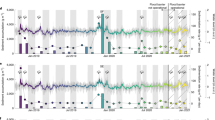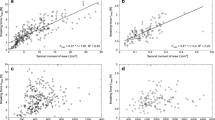Abstract
Coastal communities around the world face an increasing risk from flooding as a result of rising sea level, increasing storminess and land subsidence1,2. Salt marshes can act as natural buffer zones, providing protection from waves during storms3,4,5,6,7. However, the effectiveness of marshes in protecting the coastline during extreme events when water levels are at a maximum and waves are highest is poorly understood8,9. Here we experimentally assess wave dissipation under storm surge conditions in a 300-metre-long wave flume tank that contains a transplanted section of natural salt marsh. We find that the presence of marsh vegetation causes considerable wave attenuation, even when water levels and waves are highest. From a comparison with experiments without vegetation, we estimate that up to 60% of observed wave reduction is attributed to vegetation. We also find that although waves progressively flatten and break vegetation stems and thereby reduce dissipation, the marsh substrate remained stable and resistant to surface erosion under all conditions. The effectiveness of storm wave dissipation and the resilience of tidal marshes even at extreme conditions suggest that salt marsh ecosystems can be a valuable component of coastal protection schemes.
This is a preview of subscription content, access via your institution
Access options
Subscribe to this journal
Receive 12 print issues and online access
$259.00 per year
only $21.58 per issue
Buy this article
- Purchase on Springer Link
- Instant access to full article PDF
Prices may be subject to local taxes which are calculated during checkout



Similar content being viewed by others
Change history
30 October 2014
Supplementary data for this Letter are available online at http://doi.pangaea.de/10.1594/PANGAEA.836217
References
Woodruff, J. D., Irish, J. L. & Camargo, S. J. Coastal flooding by tropical cyclones and sea-level rise. Nature 504, 44–52 (2013).
Wong, P. P. et al. in. in Climate Change 2014: Impacts, Adaptation, and Vulnerability (ed Field, C. B. et al.) Ch. 5 (IPCC, Cambridge Univ. Press, 2014).
Loder, N. M., Irish, J. L., Cialone, M. A. & Wamsley, T. V. Sensitivity of hurricane surge to morphological parameters of coastal wetlands. Estuar. Coast. Shelf Sci. 84, 625–636 (2009).
Koch, E. W. et al. Non-linearity in ecosystem services: Temporal and spatial variability in coastal protection. Front. Ecol. Environ. 7, 29–37 (2009).
Shepard, C. C., Crain, C. M. & Beck, M. W. The protective role of coastal marshes: A systematic review and meta-analysis. PLoS ONE 6, e27374 (2011).
Gedan, K. B., Kirwan, M. L., Wolanski, E., Barbier, E. B. & Silliman, B. R. The present and future role of coastal wetland vegetation in protecting shorelines: Answering recent challenges to the paradigm. Climatic Change 106, 7–29 (2010).
Temmerman, S. et al. Ecosystem-based coastal defence in the face of global change. Nature 504, 79–83 (2013).
Bouma, T. J. et al. Identifying knowledge gaps hampering application of intertidal habitats in coastal protection: Opportunities & steps to take. Coast. Eng. 87, 147–157 (2014).
Kirwan, M. L. & Megonigal, J. P. Tidal wetland stability in the face of human impacts and sea-level rise. Nature 504, 53–60 (2013).
Jones, H. P., Hole, D. G. & Zavaleta, E. S. Harnessing nature to help people adapt to climate change. Nature Clim. Change 2, 504–509 (2012).
Kabat, P. et al. Dutch coasts in transition. Nature Geosci. 2, 450–452 (2009).
Barbier, E. B. et al. The value of estuarine and coastal ecosystem services. Ecol. Monogr. 81, 169–193 (2011).
US Army Corps of Engineers, Coastal Risk Reduction and Resilience (USACE, 2013) www.corpsclimate.us/docs/USACE_Coastal_Risk_Reduction_final_CWTS_2013-3.pdf
Spalding, M. D. et al. Coastal ecosystems: A critical element of risk reduction. Conserv. Lett. 7, 293–301 (2014).
Fagherazzi, S., Carniello, L., D’ Alpaos, L. & Defina, A. Critical bifurcation of shallow microtidal landforms in tidal flats and salt marshes. Proc. Natl Acad. Sci. USA 103, 8337–8341 (2006).
Mariotti, G. & Fagherazzi, S. Critical width of tidal flats triggers marsh collapse in the absence of sea-level rise. Proc. Natl Acad. Sci. USA 110, 5353–5356 (2013).
Möller, I., Spencer, T., French, J. R., Leggett, D. J. & Dixon, M. Wave transformation over salt marshes: A field and numerical modelling study from north Norfolk, England. Estuar. Coast. Shelf Sci. 49, 411–426 (1999).
Yang, S. L., Shi, B. W., Bouma, T. J., Ysebaert, T. & Luo, X. X. Wave attenuation at a salt marsh margin: A case study of an exposed coast on the Yangtze Estuary. Estuar. Coast. 35, 169–182 (2011).
Möller, I. & Spencer, T. Wave dissipation over macro-tidal saltmarshes: Effects of marsh edge typology and vegetation change. J. Coast. Res. 36, 506–521 (2002).
Duarte, C. M., Losada, I. J., Hendriks, I. E., Mazarrasa, I. & Marbà, N. The role of coastal plant communities for climate change mitigation and adaptation. Nature Clim. Change 3, 961–968 (2013).
Feagin, R. A. et al. Does vegetation prevent wave erosion of salt marsh edges? Proc. Natl Acad. Sci. USA 106, 10109–10113 (2009).
Paul, M. & Amos, C. L. Spatial and seasonal variation in wave attenuation over Zostera noltii. J. Geophys. Res. 116, C08019 (2011).
Mendez, F., Losada, I. & Losada, M. Hydrodynamics induced by wind waves in a vegetation field. J. Geophys. Res. 104, 18383–18396 (1999).
Kobayashi, N., Raichle, A. & Asano, T. Wave attenuation by vegetation. J. Waterw. Port Coast. Ocean Eng. 119, 30–48 (1993).
Mullarney, J. C. & Henderson, S. M. Wave-forced motion of submerged single-stem vegetation. J. Geophys. Res. 115, C12061 (2010).
Howes, N. C. et al. Hurricane-induced failure of low salinity wetlands. Proc. Natl Acad. Sci. USA 107, 14014–14019 (2010).
Allen, J. R. L. Morphodynamics of holocene salt marshes: A review sketch from the Atlantic and southern North Sea coasts of Europe. Quat. Sci. Rev. 19, 1155–1231 (2000).
Fagherazzi, S., Mariotti, G., Wiberg, P. L. & McGlathery, K. J. Marsh collapse does not require sea level rise. Oceanography 26, 70–77 (2013).
Dalrymple, R. A., Kirby, J. T. & Hwang, P. A. Wave diffraction due to areas of energy dissipation. J. Waterw. Port Coast. Ocean Eng. 110, 67–79 (1984).
Mendez, F. & Losada, I. An empirical model to estimate the propagation of random breaking and nonbreaking waves over vegetation fields. Coast. Eng. 51, 103–119 (2004).
Acknowledgements
We thank all of the staff at the Grosser Wellenkanal as well as B. Evans, J. Tempest, K. Milonidis and C. Edwards, Cambridge University, and D. Schulze, Hamburg University, for their invaluable logistical assistance, Fitzwilliam College for supporting the research time of I.M., and C. Rolfe, Cambridge University, for the soil analysis. The work described in this publication was supported by the European Community’s 7th Framework Programme through the grant to the budget of the Integrating Activity HYDRALAB IV, Contract no. 261529 and a grant from The Isaac Newton Trust, Trinity College, Cambridge.
Author information
Authors and Affiliations
Contributions
I.M., B.K.v.W., G.W., T.S., T.J.B., S.S., M.K., M.M-L., M.P. and K.J. designed the experiment. I.M., F.R., M.K., M.M-L., M.P., T.S., G.W. and S.S. participated in the construction and running of the experiment. I.M. and M.K. conducted the wave data analysis with F.R. processing biomass and video information. I.M. processed the soil elevation data and wrote the initial manuscript. All authors contributed to and approved the final manuscript.
Corresponding author
Ethics declarations
Competing interests
The authors declare no competing financial interests.
Supplementary information
Supplementary Information
Supplementary Information (PDF 306 kb)
Rights and permissions
About this article
Cite this article
Möller, I., Kudella, M., Rupprecht, F. et al. Wave attenuation over coastal salt marshes under storm surge conditions. Nature Geosci 7, 727–731 (2014). https://doi.org/10.1038/ngeo2251
Received:
Accepted:
Published:
Issue Date:
DOI: https://doi.org/10.1038/ngeo2251
This article is cited by
-
Responses of Coastal Wetlands to Rising Sea-Level Revisited: The Importance of Organic Production
Estuaries and Coasts (2024)
-
Identifying Key Plant Traits and Ecosystem Properties Affecting Wave Attenuation and the Soil Organic Carbon Content in Tidal Marshes
Estuaries and Coasts (2024)
-
Status and prospects of nature-based solutions for coastal flood and erosion risk management in the Federal State of Schleswig–Holstein, Germany
Journal of Coastal Conservation (2024)
-
Modeling wave attenuation by vegetation with accompanying currents in SWAN
Acta Oceanologica Sinica (2024)
-
What evidence exists on the performance of nature-based solutions interventions for coastal protection in biogenic, shallow ecosystems? A systematic map protocol
Environmental Evidence (2023)



